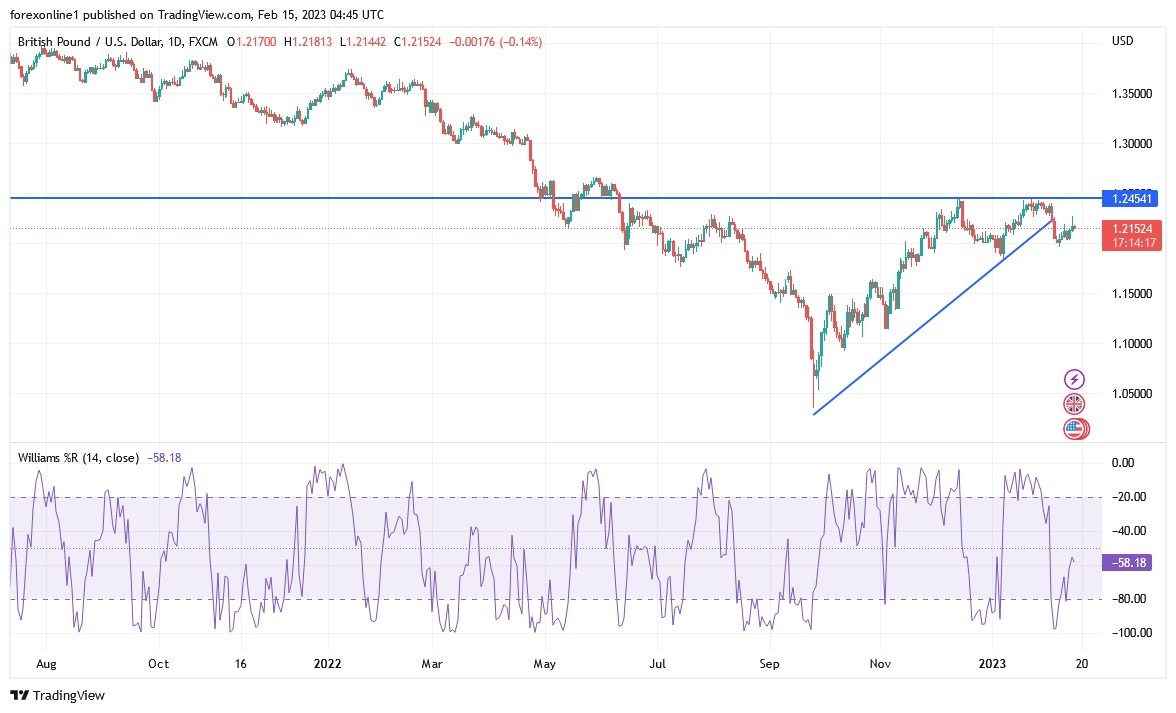[ad_1]
Prior to the announcement of the British inflation figures, the GBP/USD currency pair failed to rebound to the upside. This is after attempting to climb towards the resistance level of 1.2270, and returned on its broader path towards the support level of 1.2145 at the time of writing. The performance confirms our view of selling the currency pair from every bullish level. On the other hand, it will affect the course of the pair in the coming days. The Bank of England will make its final increase in borrowing costs in the current cycle next month to combat double-digit inflation, according to a Reuters poll showing that the British economy is definitely entering recession. The Bank of England is one of the first major central banks to start raising interest rates after the worst of the COVID pandemic, and has already added 390 basis points to the bank rate.
The poll, conducted from February 9-13, showed it would raise another 25 basis points on March 23, bringing the rate to 4.25%. In this regard, Philip Shaw, chief economist at Investec, said, “Our base case is that the Monetary Policy Committee (MPC) will raise the bank interest rate by an additional 25 basis points to 4.25% next month as an insurance policy against strong inflation pressures arising from a tight labor market.”
Separate Reuters polls found the US Federal Reserve and European Central Bank close to ending their policy tightening campaigns, but they are a little further from the end than the Bank of England. The median view of the BoE for March was held by about three-quarters of the 49 respondents, 38 of whom said it had already been. Only three expected a more aggressive move of 50 basis points.
However, when asked about the risks to their expectations of the final interest rate, 11 of the 15 respondents said that the bank interest rate ends higher than they expected.
Monetary Policy Committee member Jonathan Haskell said on Monday that the Bank of England needed to be “really cautious” about the risks of high inflation after saying last week that it remained prepared to “act aggressively” against persistent inflation. However, fellow Monetary Policy Committee member Silvana Tenero – who voted against the half-percentage-point increases earlier this month and in December – said interest rates were already too high and she might consider voting lower at future meetings.
The average of the poll did not show a BoE cut until at least April 2024. British inflation eased in December to an annualized rate of 10.5%, but the January reading, due for release on Wednesday, is expected to show it is still more than five times the bank’s 2% target of 10.3%. The poll showed that it will drift downward, but it will not be at this target or less than it until the second quarter of next year. Inflation was expected to be 7.0% this year and 2.6% the next.
Along with higher borrowing costs, consumers suffer from higher energy and food costs. Nearly two-thirds of respondents to an additional question said that it would take at least six months before the cost of living crisis eased significantly.
The Bank of England was forced to raise interest rates even though the economy is struggling after a post-pandemic boost faltered amid a cost-of-living crisis. It narrowly avoided a recession last quarter because it’s leveled off. The poll showed that the British economy would contract by 0.4% in both the first and second quarters and then contract by 0.1% in the next quarter, exceeding the technical definition of a recession.
The poll showed that the British economy will end this year 0.8 percent smaller than it was in 2023, then grow by 0.8 percent next year. This is a larger contraction than the 0.6% contraction that the International Monetary Fund predicted last month when it said Britain was the only country in the Group of Seven countries expected to contract this year.
Technical analysis of the GBP/USD pair:
- On the near term, according to the performance on the hourly chart, it appears that the GBP/USD is trading within a bullish channel formation.
- This indicates a significant short-term bullish bias in market sentiment.
- Therefore, the bulls will be looking to extend the current run of gains towards 1.2227 or higher to the 1.2298 resistance.
- On the other hand, the bears will target potential pullback profits around 1.2113 or below at support 1.2049.
On the long run, and according to the performance on the daily chart, it appears that the GBP/USD currency pair is trading within a sideways channel formation after recovering from the main decline. This indicates that the bulls are determined to maintain control of the currency pair. Therefore, they will look to pounce on extended gains at around 1.2227 or higher at 1.2440 resistance and on the other hand, the bears will target long term pullbacks at around 1.1844 or lower at 1.1641 support.

[ad_2]